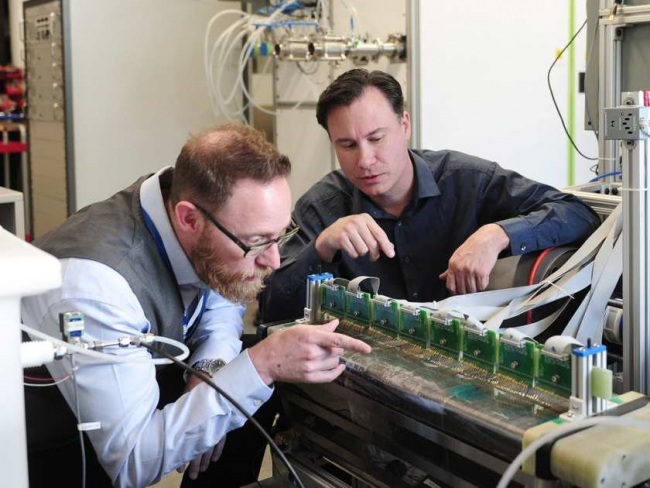Articles Menu

There is a move afoot, however, to harness fuel cells in freight transportation, with a Vancouver startup among the companies looking to replace black-exhaust-belching diesel engines in tractor trailers that are the bane of big cities from Los Angeles to Beijing.
“The emissions coming out of heavy-duty vehicles in cities are literally killing us,” said Ben Nyland, president of Loop Energy. “So there is a great opportunity in urban environments to replace polluting vehicles with zero-emission vehicles.”
It is not a sector that has attracted a lot of incentives such as California’s air-emissions regulations compel manufacturers to put zero-emission vehicles on the road, according to Eric Denhoff, CEO of the Canadian Hydrogen and Fuel Cell Association.
“The thing with trucks, the power requirements are significantly higher,” Denhoff said, and in the earlier years of fuel-cell development, manufacturers preferred to stick with developing units they were confident they could put in existing vehicle chassis.
Canada’s leaders on the heavy transportation side have been Burnaby-based Ballard Power Systems and Ontario’s Hydrogenics, which have made inroads into transit bus and train applications.
Loop Energy hopes to play a role in trucks by providing hydrogen fuel cells as part of hybrid hydrogen-electric drive trains in heavy-duty vehicles.
In Marhc, Loop, previously known as PowerDisc Development, won a $7.5-million grant from Sustainable Development Technology Canada to support the commercialization of its fuel cells in zero-emission powertrains.
And last week, the company signed a deal with Chinese transportation giant CRRC Times Electric Vehicle Co. to test Loop’s prototype fuel cell in the drive train of a yard truck, one of the tractor-trailer vehicles used to move containers around port terminals and warehouses.
“The yard truck is a very quick deployment for an existing powertrain that CRRC already has,” Nyland said. “So there’s no development work required for them, they can take something that works on a bus and put it in a yard truck.”
Where the CRRC trucks differ, Nyland said, is that they will be battery-powered electric vehicles with the fuel cells acting as portable battery chargers compared with the more typical fuel-cell vehicle where the cell replaces the internal combustion engine for a car or bus.
The advantage of the electric approach, Nyland said, is that it is a fuel cell that doesn’t need to be big enough to supply the vehicle’s peak power needs, which makes the vehicles more cost competitive.
“Fuel cells solve — it’s become a famous phrase — the ‘range anxiety’ associated with heavy-duty (electric) vehicles,” Nyland said.
The objective, he said, is to reach a point where such vehicles are cost competitive with natural gas-powered highway trucks with prices in the $200,000 range. Produced in larger numbers, Nyland hopes to be more competitive with diesel trucks in the $150,000 range.
Cost has been one of the big barriers to the adoption of fuel cells in freight transportation, Nyland said. Trucking companies are more sensitive to the economic case, versus bus transportation where publicly operated transit systems are often more willing to pay a premium to test zero-emission standards.
Denhoff said lower-emission natural gas-powered vehicles also faced challenges breaking into the market due to the cost factor, although more companies are adopting them into their fleets.
Incentives are also increasing to put zero-emission trucks on the road.
California, last week, awarded a $23-million US grant to four major manufacturers to put 43 electric-drive or plug-in hybrid trucks into the ports of Los Angeles and Long Beach.
Those huge facilities, which handle the biggest percentage of imported shipping containers to the U.S. west coast, face a lot of pressure to reduce the emissions associated with truck traffic.
And locations such as Los Angeles are the places where Denhoff believes fuel cells will be able to compete as a power source for vehicles.
“The best markets are probably areas with a very high pollution factor, so they’re willing to invest in infrastructure and pay a premium for vehicles,” Denhoff said.
It makes sense for fuel-cell development to move into bigger applications, said Walter Merida, director of the clean energy research centre at the University of B.C., because they make up a significant portion of the air pollution from transportation.
“It’s a larger problem than personal mobility, so absolutely we need to look at heavy-duty applications,” Merida said.
“Mining trucks, rail, ferries, you name it,” he said. “I’m not familiar with (Loop), but I’m not surprised that they are looking at that,” Merida said, “because it’s the next logical step.”